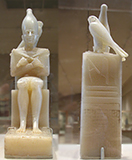
Nechtanebo-the-Falcon (?)
Late Period, 30th Dynasty, reign of Nectanebo II (360-343 BCE)
Graywacke, probably from Heliopolis
Rogers Fund, 1934 (34.2.1)
|
|
|
From info card and Museum website: "From the earliest dynasties, the ancient Egyptians believed that their king was divine, an incarnation of the great sky god Horus. The king ruled as the living Horus and the god was protector of the human king. This identification of king and god is represented in statuary as early as Dynasty 4 in a famous seated statue in the Egyptian Museum, Cairo, that represents Menkaure with a falcon protectively spreading its wings around the back of the king's head."
 (The Brooklyn Museum has a statue of Pepy I (Dynasty Six) with the Horus Falcon on his shoulder)
"Some two thousand years later the same theme is depicted in this statue of Horus with King Nectanebo II, the last ruler of Dynasty 30.
"In this statue, Horus is represented as a fearsome bird of prey, with sharp eyes and dangerous talons. His double crown, symbolizing dominion over Upper and Lower Egypt, is graced with the rearing cobra, or uraeus, another divine protector of the ruler. The small figure of Nectanebo stands between the great talons, wearing a nemes headcloth and uraeus."
"The pharoah Nectanebo II often invoked a very close connection - even a merging -between himself and the falcon god of kingship, Horus. In fact, Nectanebo II was the focus of a cult in which he was referred to as 'Nectanebo-the-Falcon,' which could indeed be what is represented by this striking conjunction of a powerful falcon and the monarch. This idea seems to be supported by the fact that Horus is not named on the base but only Nectanebo and the god Osiris-Mnevis, at whose sanctuary in Heliopolis the statue may have been erected.
"The composition may be read as a rebus of the Nectanebo's Egyptian name, Nakhthorheb: nakht, the sword held in the king's left hand; Hor, the falcon; and heh, the festival sign in the king's right hand. The last sign probably refers to the city of Hebyt, which was the site of the great temple constructed by Nectanebo II for Isis, mother of Horus."
"The statue follows the late Dynastic period tradition of depicting animal images in hard stone with remarkably naturalistic details in head and feet, while the body and wings are simplified renderings of the bird's natural form."
  
|